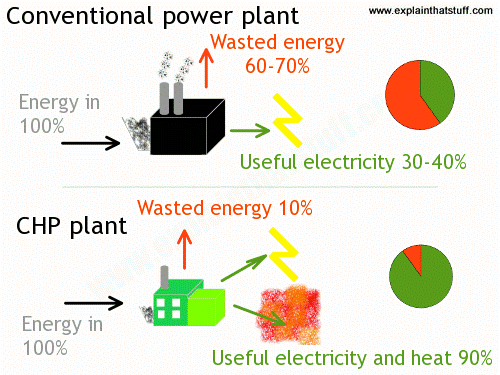
Cogeneration is the simultaneous production of two or more types of energy from a single fuel source. It is also known as combined heat and power, distributed generation, or recycled energy. Cogeneration power plants are typically 50 to 70 percent more efficient than single-generation facilities. In practice, cogeneration is the utilization of what would otherwise be wasted heat (such as a manufacturing plant’s exhaust) to generate extra energy advantage, such as heat or electricity for the building in which it is running. Cogeneration is beneficial to both the bottom line and the environment since recycling waste heat prevents other polluting fossil fuels from being burnt.
Although combined heat and power (CHP) technology is often referred to as cogeneration, there are significant distinctions. Cogeneration is the process by which a simple cycle gas turbine generates electricity and steam, as well as steam utilized in other processes such as drying. The steam, however, is not utilized to power a steam turbine.
CHP combined-cycle power plants may generate both electricity and usable heat energy from a single fuel. Thermal energy (steam or hot water) collected may be utilized for operations such as heating and cooling, as well as generating electricity for various industrial uses. CHP is used by manufacturers, municipalities, commercial buildings, and institutions such as universities, hospitals, and military sites to cut energy costs, improve power dependability, and minimize carbon emissions.
What is the process of cogeneration ?
A cogeneration plant is similar to a CHP plant in that it generates both electricity and heat. Cogen technology, on the other hand, differs from CHP in that it generates energy using a simple cycle gas turbine. The exhaust energy from the gas turbine is then utilized to generate steam. The steam is then utilized entirely in other processes, rather from being channeled to operate a steam turbine as in CHP.
What is the operation of a CHP power plant ?
A CHP power plant is a decentralized, energy-efficient way of producing heat and electricity. CHP plants may be installed in a single building or business, or they can provide electricity for a district or utility.
In CHP, a fuel is utilized to power the primary mover, which generates both electricity and heat. The heat is then utilized to bring water to a boil and create steam. Some of the steam is utilized to power a process, while the rest is used to power a steam turbine, which generates more power. In a cogen application, the steam is completely used in a process that generates no extra electricity.
Advantages of Combined Heat and Power
When compared to traditional energy generation, a CHP power plant may provide many benefits and advantages, including:
- Greater efficiency: CHP generates both electricity and heat while using less fuel than conventional energy plants. Furthermore, it collects heat and steam to produce extra power, reducing the demand for fuel even further.

- Lower emissions: Because CHP systems consume less fuel, they may decrease greenhouse gas emissions and other air pollutants.
- Lower running expenses: The efficiency of CHP lowers down operating costs and may offer a hedge against rising energy prices.
- Dependability: Because CHP is an onsite energy plant, it reduces dependence on the energy grid and may provide greater energy security and reliability of power generation even in the event of a catastrophe or grid interruption.
- District heating: Cogeneration systems are used in district heating power plants to supply both energy and heating to local facilities and residences. Unused steam is channeled to generate extra electricity when a CHP system is utilized for district heating.
- Industrial manufacturing: Industrial CHP plants enable businesses that use a lot of energy to generate their own steady supply of electricity while improving efficiency and lowering fuel usage. CHP systems may power a broad range of industrial and manufacturing operations while also producing usable energy such as high-pressure steam, process heat, mechanical energy, or electricity.
- Commercial structures: From commercial office buildings and airports to casinos and hotels, CHP plants assist to provide clean, dependable electricity that helps fulfill baseload needs while lowering energy costs. Steam heats and cools the environment while also generating energy to power lights and electronics.
- Institutions: Colleges and universities, hospitals, jails, military posts, and other institutions depend on CHP plants to fulfill their electrical and thermal energy requirements, as well as to improve power reliability. The CHP system may substantially reduce the costs and emissions associated with conventional forms of power generation.
- Municipal applications: CHP is ideal for municipal wastewater treatment facilities. Anaerobic digestion generates biogas in these facilities, which may be used to power onsite generators.
- Residential: CHP systems can power energy-intensive multifamily buildings or assist single-family houses fulfill their energy requirements.
CHP for big structures and infrastructures
combined heat and power generation (CHP) effectively contributes to the production of electricity for hospitals, airports, and other big institutions. CHP generating solutions not only help operators avoid substantial supply and distribution losses, but they also save 40% more fuel than separate generation and may help improve overall efficiency, profitability, and environmental responsibility.
https://www.gmsthailand.com/blog/what-is-the-operation-of-a-chp-power-plant/




























